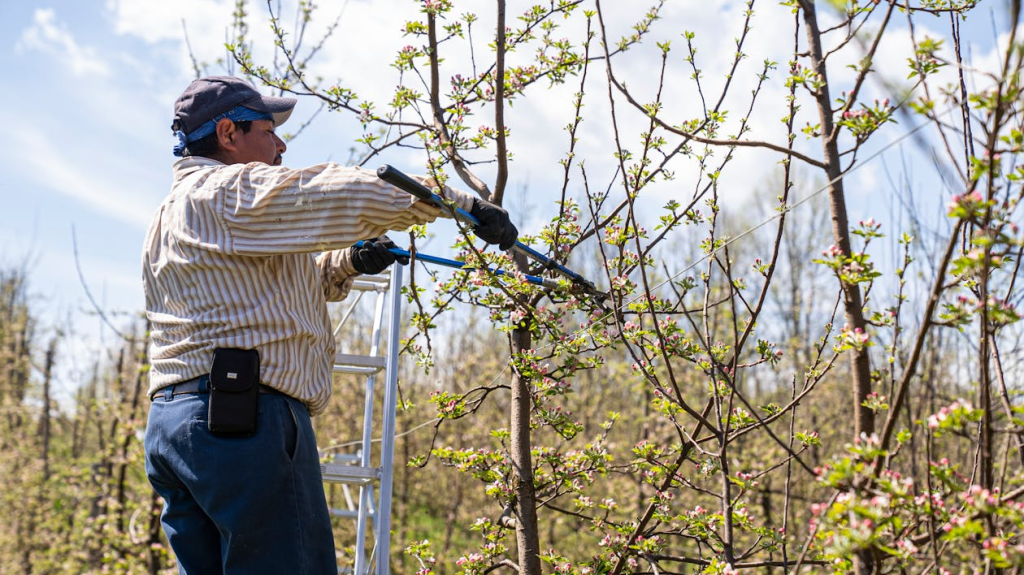Cutting and removing a tree may seem like a straightforward task, but it requires a great deal of skill and careful planning to avoid accidents or damage.
Whether you have a small tree in your yard or need to clear a larger one, understanding the safe practices for DIY tree cutting and removal is essential for ensuring both your safety and the wellbeing of your property.

This guide will provide key safety tips, tools, and techniques for tree cutting. Additionally, if you’re dealing with root problems and wondering how to kill roots of a tree, we will discuss that too.
Why Tree Cutting and Removal Requires Care
While it may be tempting to tackle tree removal yourself to save on costs, it is important to realise that it can be hazardous. Tree cutting involves the risk of falling branches, swinging chainsaws, and unstable trees.
A lack of knowledge can result in serious injury or damage to property. Furthermore, removing a tree is not always as simple as it appears. Factors like the tree’s size, location, and health will all influence the removal process.
Understanding these risks is the first step in ensuring a safe and successful tree removal process.
Essential Tools for DIY Tree Cutting
Before attempting to cut down a tree, you must have the right tools on hand. Using improper equipment can not only make the task more difficult but also increase the likelihood of accidents. Here is a list of the basic tools required for tree cutting and removal:
1. Chainsaw
A chainsaw is the most common and effective tool for cutting down trees, particularly larger ones. It provides the power needed to make clean cuts quickly and efficiently. For smaller trees, a pruning saw or handsaw may suffice.
Things to remember when using a chainsaw:
Ensure the chainsaw is in good condition and sharpened regularly. Use the correct size chainsaw for the tree you plan to cut. Familiarise yourself with the operating instructions and safety features.
2. Safety Gear
Safety should be your top priority when cutting down a tree. The following safety equipment is essential for protecting yourself from injury:
- Helmet with face shield or goggles: Protects your head and eyes from falling debris.
- Hearing protection: Chainsaws are loud and prolonged exposure can damage your hearing.
- Protective clothing: Wear long sleeves, pants, and chainsaw chaps to protect against cuts.
- Sturdy boots: Essential for stability and protecting your feet from falling branches or tools.
3. Ropes and Wedges
Ropes can help guide the tree as it falls, ensuring that it lands in a safe area. Wedges can also be used to control the direction in which the tree falls, especially if the tree is leaning.
Ropes and wedge tips
Always use strong, durable ropes designed for tree cutting. Place wedges on the opposite side of the tree’s lean to help direct the fall.
4. Pruning Tools
Before cutting down the main trunk, you may need to prune branches to reduce the weight and make the process easier. Pruning shears, loppers, and pole saws are useful for removing small branches and clearing the area around the tree.
Step-by-Step Guide to Safe Tree Cutting
Once you have the necessary tools and safety equipment, it’s time to plan the tree cutting process. Follow these steps to ensure you complete the task safely and effectively.
1. Assess the Tree and the Area
Before you start cutting, carefully assess the tree and its surroundings. Consider the following:
- Tree health: Check if the tree is diseased or dying. A diseased tree can be unstable and difficult to predict during cutting.
- Tree lean: If the tree is leaning in a particular direction, it is essential to plan the cut accordingly to prevent it from falling the wrong way.
- Surrounding obstacles: Ensure there are no structures, power lines, or other trees in the way. This will help you avoid damage and injury.
How to assess a tree:
- Inspect the tree for cracks, signs of disease, or leaning.
- Look for any objects or structures that the tree might hit when it falls.
- Ensure that you have a clear escape route if the tree starts to fall unexpectedly.
2. Make the Notch Cut
The notch cut is the first cut you make on the tree and is crucial for controlling the direction of the fall. The notch should be made on the side of the tree facing the direction you want it to fall.
This cut should be made at a 70-degree angle and should be about one-third of the way through the tree.
3. Make the Felling Cut
Once the notch cut is complete, you can proceed with the felling cut. The felling cut is made on the opposite side of the notch and slightly above it. This cut should be horizontal and should be about 2.5 cm higher than the horizontal part of the notch.
4. Use Wedges for Direction Control
If the tree is not falling in the desired direction, wedges can be inserted into the felling cut to help direct its fall. Gently tap the wedges with a hammer to push the tree in the right direction.
5. Retreat and Wait for the Tree to Fall
As the tree begins to lean, it’s time to step back and move to a safe distance. Trees can fall unexpectedly, so always make sure you have a clear escape route. Keep in mind that it’s best to retreat at a 45-degree angle from the direction of the fall.
Removing the Tree Stump and Roots
Once the tree has fallen, you may need to remove the stump and roots. Stump removal can be a complicated process, as the roots may spread deep into the soil.
If you’re dealing with stubborn roots, you might wonder how to kill roots of a tree. Here are some methods for dealing with tree stumps and roots:
1. Manual Removal
You can use an axe, shovel, or digging bar to manually remove the stump and roots. This method can be very labour-intensive, especially for larger trees, but it is the most cost-effective.
2. Chemical Removal
If you’re looking to speed up the process, you may choose to apply a tree root killer product. These chemicals break down the root system, allowing you to remove the stump more easily.
3. Grinding
Stump grinders are powerful machines that can grind the tree stump down below the soil level, leaving you with a smooth surface. These are available for rent or can be used by a professional arborist.
Conclusion
Cutting and removing a tree on your property is a task that should never be taken lightly. While DIY tree cutting can save you money, it requires the right tools, safety precautions, and techniques.
Always assess the tree and its surroundings before starting and ensure you have the right equipment and protective gear. If the task seems beyond your capabilities, consider hiring a professional arborist to handle the job safely.
Whether you’re dealing with a small tree or need help with root removal, following these safe practices will help you achieve your goal without unnecessary risks.
Frequently Asked Questions
How do I know if I can cut down a tree myself?
If the tree is small and healthy, you may be able to cut it down yourself using the proper equipment. However, if the tree is large, leaning, or diseased, it’s best to call a professional arborist.
What should I do if the tree is near power lines?
If the tree is near power lines, it’s best to hire a professional tree removal service. Cutting near power lines is extremely dangerous, and safety protocols must be followed.
How do I safely dispose of a large tree stump?
You can either remove the stump manually, grind it down, or apply chemicals to kill the roots. If the stump is large, it’s often best to hire a professional service for stump removal.
